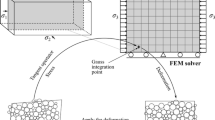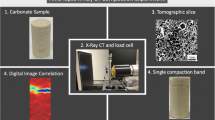Abstract
Since Mollema and Antonellini observed compaction bands in the field in 1996, different patterns of compaction bands have been found in laboratory experiments. There are some discrepancies between the laboratory experiments and the field observations: compared to the field observation, the stress levels required to induce compaction bands in laboratory experiments are usually higher than the inferred in the field, and the grain crushing are more intense in the laboratory experiments. In this paper, compaction bands were observed at the maximal principal stresses below 8 MPa, which is lower than the stress level inferred in the field, and there was no severe comminution inside the compaction bands. Experimental results indicate that the porosity and confining pressure have great impacts on the types of localization bands. Lower porosity and confining pressure can promote the growth of shear bands and high-angle shear bands. Higher porosity and confining pressure can promote the growth of discrete compaction bands. Intermediate porosity and confining pressure are favorable for the growth of hybrid modes involving two of the three, i.e., discrete compaction band, diffuse compaction band and high-angle shear band. The formation of discrete compaction bands is more unstable compared to diffuse compaction bands. The two types of compaction bands can appear in the same type rocks, and diffuse compaction bands are formed under lower confining pressure compared to discrete compaction bands. The reduction of permeability was within 2 orders of magnitude in this study, and it is 2-3 orders of magnitude lower than those obtained by other researchers.
Similar content being viewed by others
References
Mollema P N, Antonellini M A. Compaction bands: A structural analog for anti-mode I cracks in Aeolian sandstone. Tectonophysics, 1996, 267: 209–228
Baud P, Klein E, Wong T F. Compaction localization in porous sandstones: Spatial evolution of damage and acoustic emission activity. J Struct Geol, 2004, 26: 603–624
Holcomb D, Rudnicki J W, Issen K A, et al. Compaction localization in the Earth and the laboratory: State of the research and research directions. Acta Geotech, 2007, 2: 1–15
Wong T F, Baud P. Grain crushing, pore collapse and strain localization in porous sandstone. Mechanics of Natural Solids. Berlin Heidelberg: Springer-Verlag, 2009. 239–254
Olsson W A. Theoretical and experimental investigation of compaction bands in porous rock. J Geophys Res, 1999, 104: 7219–7228
Olsson W A, Holcomb D J. Compaction localization in porous rock. Geophys Res Lett, 2000, 27: 3537–3540
Wong T F, Baud P, Klein E. Localized failure modes in a compactant porous rock. Geophys Res Lett, 2001, 28: 2521–2524
Haimson B C. Borehole breakouts in Berea sandstone reveal a new fracture mechanism. Pure Appl Geophys, 2003, 160: 813–831
Haimson B, Kovacich J. Borehole instability in high-porosity Berea sandstone and factors affecting dimensions and shape of fracture-like breakouts. Eng Geol, 2003, 69: 219–231
Haimson B. Fracture-like borehole breakouts in high-porosity sandstone: Are they caused by compaction bands?. Phys Chem Earth, 2001, 26: 15–20
Haimson B, Lee H. Borehole breakouts and compaction bands in two high-porosity sandstones. Int J Rock Mech Min, 2004, 41: 287–301
Fôrtin J, Sanchits S, Dresen G, et al. Acoustic emission and velocities associated with the formation of compaction bands in sandstone. J Geophys Res, 2006, 111: B10203
Wong T F, Baud P. Mechanical compaction of porous sandstone. Oil Gas Sci Technol, 1999, 54: 715–727
Townend E, Thompson B D, Benson P M, et al. Imaging compaction band propagation in Diemelstadt sandstone using acoustic emission locations. Geophys Res Lett, 2008, 35: L15301
Stanchits S, Fortin J, Gueguen Y, et al. Initiation and propagation of compaction bands in dry and wet Bentheim sandstone. Pure Appl Geophys, 2009, 166: 843–868
Charalampidou E M, Hall S A, Stanchits S, et al. Characterization of shear and compaction bands in a porous sandstone deformed under triaxial compression. Tectonophysics, 2011, 503: 8–17
Holcomb D J, Olsson W A. Compaction localization and fluid flow. J Geophys Res, 2003, 108: B62290
Vajdova V, Baud P, Wong T F. Permeability evolution during localized deformation in Bentheim sandstone. J Geophys Res, 2004, 109: B10406
Sternlof K R, Rudnicki J W, Pollard D D. Anticrack inclusion model for compaction bands in sandstone. J Geophys Res, 2005, 110: B11403
Klein E, Baud P, Reuschle T, et al. Mechanical behavior and failure mode of Bentheim sandstone under triaxial compression. Phys Chem Earth, 2001, 26: 21–25
Vajdova V, Wong T F. Incremental propagation of discrete compaction bands: acoustic emission and microstructural observations on circumferentially notched samples of Bentheim sandstone. Geophys Res Lett, 2003, 30: 1775
Tembe S, Vajdova V, Wong T F, et al. Initiation and propagation of strain localization in circumferentially notched samples of two porous sandstones. J Geophys Res, 2006, 111: B02409
Loaiza S, Fortin J, Schubnel A. Mechanical behavior and localized failure modes in a porous basalt from the Azores. Geophys Res Lett, 2012, 39: L19304
Schultz R A, Soliva R. Propagation energies inferred from deformation bands in sandstone. Int J Fract, 2012, 176: 135–149
Tembe S, Baud P, Wong T F. Stress conditions for the propagation of discrete compaction bands in porous sandstone. J Geophys Res, 2008, 113: B09409
Bqxevqnis T, Papamichos E, Flornes O, et al. Compaction bands and induced permeability reduction in Tuffeau de Maastricht Calcarenite. Acta Geotech, 2006, 1: 123–135
Rudnicki J W. Models for compaction band propagation. In: Rock Physics and Geomechanics in the Study of Reservoirs and Repositories. London: Geological Society of London Special Publication, 2007. 284
Zhu W, Wong T F. The transition from brittle faulting to cataclastic flow: Permeability evolution. J Geophys Res, 1997, 102: 3027–3041
Cheung C S N, Baud P, Wong T F. Effect of grain size distribution on the development of compaction localization in porous sandstone. Geophys Res Lett, 2012, 39: L21302
Sun W, Andrade J E, Rudnicki J W, et al. Connecting microstructural attributes and permeability from 3D tomographic images of in situ shear-enhanced compaction bands using multiscale computations. Geophys Res Lett, 2011, 38: L10302
Ballas G, Soliva R, Sizun J P, et al. Shear-enhanced compaction bands formed at shallow burial conditions; implications for fluid flow (Provence, France). J Struct Geol, 2013, 47: 3–15
Meredith P, Baud P, Heap M J. et al. Influence of compaction bands and stylolites on the permeability of porous rocks. In: Flows and Mechanics in Natural Porous Media from Pore to Field Scale. Pore2Field. France: IFP Energies nouvelles, 2011
Louis L, Baud P, Wong T F. Compaction localization in high porosity sandstones with various degrees of heterogeneity: insight from X-ray computed tomography. In: ROCKEN09: Proceedings of the 3rd CANUS Rock Mechanics Symposium. Toroto, 2009
Katsman R, Aharonov E, Scher H. Numerical simulation of compaction bands in high porosity sedimentary rock. Mech Mater, 2005, 37: 143–162
Wang B, Chen Y, Wong T F. Adiscrete element model for the development of compaction localization in granular rock. J Geophys Res, 2008, 113: B03202
Louis L, Wong T F, Baud P, et al. Imaging strain localization by Xray computed tomography: discrete compaction bands in Diemelstadt sandstone. J Struct Geol, 2006, 28: 762–775
Pons A, David C, Fortin J, et al. X-ray imaging of water motion during capillary imbibition: A study on how compaction bands impact fluid flow in Bentheim sandstone. J Geophys Res, 2011, 116: B03205
Charalampidou E M, Hall S A, Stanchits S, et al. Shear-enhanced compaction band identification at the laboratory scale using acoustic and full-field methods. Int J Rock Mech Min, 2013, http://dx.doi.org/10.1016/j.ijrmms.2013.05.006i
Schultz R A. Relationship of compaction bands in Utah to Laramide fault-related folding. Earth Planet Sc Lett, 2011, 304: 29–35
Chemenda A I. Origin of compaction bands: Anti-cracking or constitutive instability?. Tectonophysics, 2011, 499: 156–164
Author information
Authors and Affiliations
Corresponding author
Rights and permissions
About this article
Cite this article
Han, G., Liu, X. & Wang, E. Experimental study on formation mechanism of compaction bands in weathered rocks with high porosity. Sci. China Technol. Sci. 56, 2563–2571 (2013). https://doi.org/10.1007/s11431-013-5322-2
Received:
Accepted:
Published:
Issue Date:
DOI: https://doi.org/10.1007/s11431-013-5322-2




